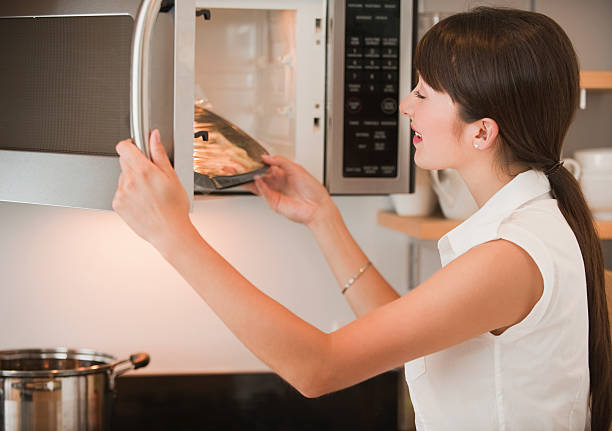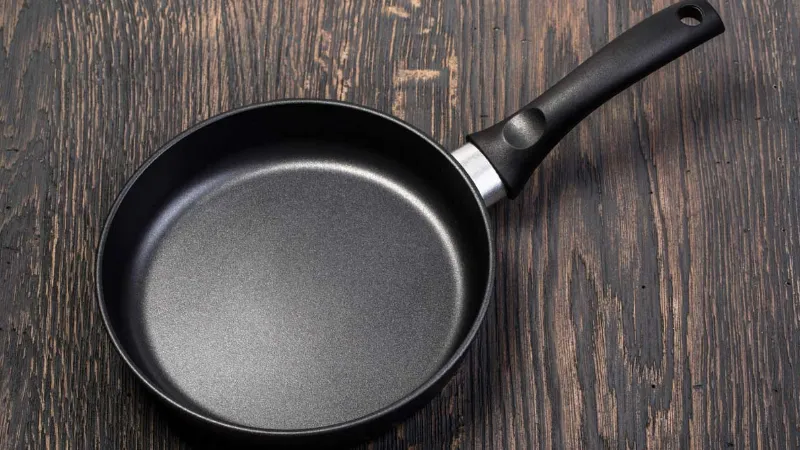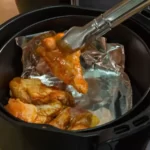Can You Microwave Aluminum Foil? Yes, But…
Yes, you may microwave aluminum foil, but only if you take particular safety precautions.
In general, placing metal in the microwave is a bad idea, but aluminum foil gets a pass if certain precautions are taken. We’ll go through these in more depth below.
Table of Contents
How Microwaves Work
Microwaves generate radio waves, which force the water molecules in food to spin and heat up due to friction. The heat is carried to the center of the object by the conductive characteristics of the food or liquid.
These microwaves will be reflected by metal. This is why a microwave is essentially a large, secure metal enclosure – to prevent you from cooking everything in the area around you. When you place a thick piece of metal in the microwave (such as a pot pie pan), the microwaves are simply bounced back and forth between the pan and the microwave walls.
A thin sheet of metal, such as a strip of aluminum foil, cannot withstand the microwave radiation and will quickly heat up and ignite. The microwave’s electromagnetic field causes a current to flow through the foil, and if the foil is crinkled into sharp edges, the current discharges as dazzling sparks.
What Happens When Aluminum Foil Is Microwaved?
What occurs in the microwave with food may not be the same with metal, particularly aluminum foil. The issue isn’t the standard thickness of aluminum foil, but rather that metal acts like a mirror in the microwave, preventing your food from absorbing the microwaves.
As a result, items totally coated in aluminum foil should not be microwaved since they get no heat at all. But it is not the reason we are warned that using aluminum foil in the microwave is unsafe.
Putting aluminum foil in the microwave creates an electric field that neither the microwave circuits nor the foil can withstand. When your meal is completely coated in aluminum foil, the microwave’s electrical currents cannot be absorbed.
Those electricity currents will continue to bounce off one other, creating enormous heat that can burn the foil or the microwave’s internal circuits. However, placing aluminum foil in the microwave, especially crumpled foil, poses an even greater risk.
Actually, some of the electric currents will not be reflected and will continue to wiggle about the foil. These electrons congregate to an extraordinary number at the foil’s corners or sharp edges, get bounced by their neighbors, and then begin arcing.
Although aluminum foil is known for its excellent heat resistance, if the arcing hits something combustible, there is a substantial chance of explosion.
So, to cut a long tale short, I recommend that you use alternative equipment while utilizing aluminum foil. Of course, you should still check to see if aluminum foil is okay to use in toaster ovens, ovens, toasters, or air fryers. They are, nevertheless, a better fit than microwave.
That being said, I’m sure you’re already well-versed in aluminum foil by now. So you’re certainly aware of the dangers of using foil in crockpots and other popular kitchen gadgets. Am I correct?
In the microwave, aluminum foil can cause arching and even explosions.
So Can You Microwave Aluminum Foil?
In fact, using tiny quantities of aluminum foil in a microwave oven can be safe.
No food should be microwaved that is entirely wrapped in aluminum foil or in a covered metal pan because the microwaves will not be absorbed by the food. This will damage or possibly burn the oven. Small strips of aluminum foil, on the other hand, can be used to “shield” sections of dishes, such as chicken drumsticks and wings, to prevent overcooking.
Some foods wrapped in foil containers can be microwaved safely. Check the package heating directions to check if the food maker recommends microwaving the product. Because food in these containers will only heat from the top, microwave meals about 1-2 inches deep so that food towards the bottom is properly cooked before food on top dries and overcooks.
Aluminum Foil Cookware In Different Types
You’ve undoubtedly seen at least one or two different types of aluminum cookware at the supermarket, a cafe, or a bakery.
Here are some of the most common aluminum foil cooking and baking materials that are routinely discarded:
- Pie dishes
- Pans for roasting
- Utensils
- tins for bread loaves
- Cake tins
- Table pans steamed
So, can they be microwaved? Yes and no on occasion. It differs from one manufacturer to the next.
If you prefer to preserve them rather than throw them away after one use (which is perfectly OK), you may be unable to microwave them though they get twisted and deformed, even if they were microwavable when you purchased them. This is in addition to not microwaving crinkled aluminum foil sheets.
How to Avoid the Dangers of Microwaving Aluminum Foil
Appetizing Baked Chicken Legs Potatoes
Wrap the bone section of bird drumsticks with a tiny piece of aluminum foil.
So the preceding piece is the theory, yet there are still recipes from expert chefs that call for aluminum foil and may be cooked in the microwave. I’m sure the facts will perplex you.
In truth, you can still use aluminum foil in the microwave, but there are some unavoidable consequences. Because aluminum reflects microwaves, a thin piece of aluminum foil can be employed as a “shield” in a microwave oven.
Aluminum foil may be used in the microwave in the same way as it is used to cover the tops of poultry drumsticks to protect them from overcooking or burning.
However, keep in mind that this may effect whether or not aluminum foil can be recycled, especially if there is too much food and grease stuck to the foil afterward.
Here are some important points to remember when using that approach, as well as other microwave cooking methods with aluminum foil.
Tips for Safely Using Foil in a Microwave
Only use new, smooth foil. Arcing can be caused by wrinkled foil (sparks).
Wrap foil around no more than 1/4 of the meal.
Smoothly shape the foil around the meal so that no corners protrude.
It makes no difference either side of the foil is facing out (shiny or dull).
Place the foil no more than one inch from the oven’s walls.
If your microwave oven includes metal shelves or a metal turntable, don’t microwave food in foil containers or metal pans, and don’t allow shielding foil come into contact with or be close to the shelves or platter.
If you detect arcing (sparks), remove the foil shielding immediately and transfer frozen food from the foil container to a microwave-safe utensil.























